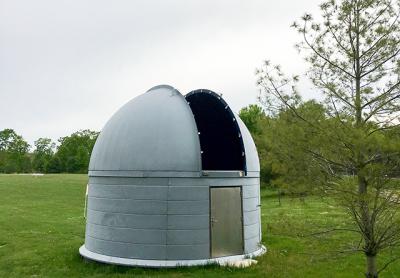Star-Watchers Have Reason To Rejoice

With so much going on around us on the East End every summer, some might forget to look up. But to the founders of the Montauk Observatory, the heavens, and our unobstructed view of stars, planets, and the Milky Way are worthy of attention — and a decade of effort.
With an observatory building nearing completion on the campus of the Ross School in East Hampton, which donated a space, it will not be long before scientists and amateur astronomers will be able to book a slot online and remotely command the observatory roof to slide open, allowing a professional-grade telescope to home in and transmit a view of the night sky to a user’s computer screen. The eventual addition of a camera will allow people using the telescope to photograph celestial images.
“As a kid I was an amateur astronomer,” Terry Bienstock, the president of the Montauk Observatory’s executive board, said this week. For decades, he said, “life got in the way.” Now semiretired (he was an executive vice president and general counsel for Comcast Cable Communications), he decided he wanted to provide opportunities for youngsters who shared his interest and help to advance science studies on the East End.
Ten years ago, after reading about an effort by former East Hampton Town Supervisor and County Legislator Jay Schneiderman (now the Southampton supervisor) to have a telescope installed at the Montauk County Park, Mr. Bienstock got on board.
Mr. Schneiderman had found a large telescope available for sale at the Biosphere II earth sciences research facility in Arizona and had gotten the county to approve its purchase for $250,000. When the county executive vetoed the expenditure, Mr. Bienstock and several others formed a private group to raise the money.
After two astronomers they flew out to Arizona gave the Biosphere telescope the thumbs-up, the group — which included Susan Harder, the founder of the Dark Sky Society in East Hampton; Sean Tvelia, a Suffolk County Community College physical science professor and a fellow of the Royal Astronomical Society; Matthew Putnam, a Columbia University professor and researcher with a doctorate in applied physics, and David Larkin, a businessman — set to work to raise some $400,000 to cover both the telescope and a building to enclose it at the park. Years of wrangling to secure an agreement for a permanent home base ensued. The county park was abandoned and the Ross School stepped up.
In the meantime, however, the astronomy group had a stroke of luck. Perusing an astronomy magazine, Mr. Bienstock learned about plans by Meade Instruments, a leading telescope manufacturer, to mass-produce professional-grade telescopes for the first time at a $35,000 sale price. “That changed everything,” Mr. Bienstock said.
With a call to Meade’s C.E.O., he secured a promise for the chance to purchase the first one off the assembly line.
A motorized ramp allowed users to roll the telescope in and out of a storage shed at the Montauk County Park, and “we started having star parties and events and lectures,” Mr. Bienstock said.
Through a partnership with the American Museum of Natural History’s Rose Planetarium, speakers — about one a month throughout the year — have included astrophysicists and other scientists as well as authors of nonfiction science works such as Dava Sobel. The group also bought a portable StarLab planetarium, which has been set up for shows at schools and other sites. A collection of small telescopes allows for stargazing programs at a variety of locations and customized “star parties” led by astronomers.
“Our goal was to make everything we do available to the public for free,” Mr. Bienstock said. A prefabricated 15-by-15-foot observatory building was donated by the Custer Institute in Southold, another astronomy group, and setup is being completed at the Ross School with the help of Tom Frey Construction. Ongoing fund-raising is conducted for the construction and for educational programs.
“We have a fantastic summer program,” Mr. Bienstock said this week. It begins on June 21, the summer solstice, with a program at the Montauk Library at which William Francis Taylor, a NASA Solar System Ambassador, will discuss the nature and history of the solstice. Sky observations, weather permitting, will follow. In August there will be programs leading up to and observing the Aug. 21 solar eclipse. Complete information can be found at montaukobservatory.com, or those interested may sign up for email alerts by contacting Donna McCormack, the observatory’s director, at [email protected].
Ms. McCormack was involved in the Custer Institute before taking the reins here, and was a researcher in parapsychology at the American Society for Psychical Research in New York City. With a research faculty that included scientists, psychologists, and engineering professors from Princeton, Harvard, and Yale, the institute, Ms. McCormack said, was “investigating various states of consciousness,” and doing lab work “trying to get at the nature of the phenomena.”
“It was a fascination of mine for many years,” said Ms. McCormack, who studied psychology, education, and was in nonprofit administration and development. “I was always curious about human nature . . . our experience on Earth . . . things that are less understood.”
She and the others involved hope that, once completed, the Montauk Observatory telescope and building will help to pique curiosity and spur scientific and other inquiry.
